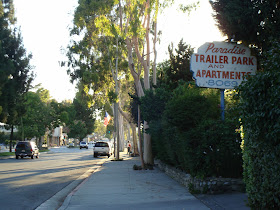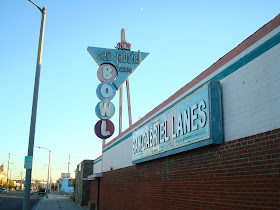 |
| The Durfee Ranch, a 125-acre farm, once existed near here. The pictured street sign is at the intersection of Durfee and Peck Road, located in South El Monte. Durfee Avenue continues at this point northward through the city of El Monte, becoming disconnected but resumes until it reaches its termination at the border of Arcadia. From the same intersection at Peck, Durfee Avenue is also a country road stretching west into the unincorporated L.A. County section, this time halting at Rosemead Boulevard. Another segment of Durfee begins at the Pico Rivera border, reaching southward until Whittier Boulevard. |
Headed West from Illinois
James Devine Durfee, nearly 14 years of age, accompanied his older brother George W. (age 31) to California in September, 1854. The family name Durfee is derived from the French d'Urfé. Durfee descendants hailed from Rhode Island, and both their parents were deceased by 1847. The brothers departed from Carroll County, Illinois with oxen hitched to a wagon. When the team gave out, they both walked 250 miles to reach San Bernardino one year after they started from Illinois. George was already married (to Laura Cleminson); they had three children and one baby on the way before they left heading west. While in route, a daughter was born in Council Bluffs, Iowa, so perhaps the wife and children stayed behind. Eventually everyone resided in San Bernardino for a handful of years. Two more of George's children were born there. Also, in 1858 James married Laura Cleminson's sister, Diantha. Both brothers moved to the El Monte area, with records indicating that James set up a farm in November, 1859. In later years, George re-settled in Los Angeles, while James stayed for the remainder of his life.
Place Names Reflect Farming Pioneers
James Durfee grew prominent, outspoken and active in local affairs. One of his sons, James Roswell Durfee (born 1874) also started a family and farmed nearby. It may be that other Durfee relatives eventually settled here too, attributing to the numerous segments of Durfee Avenue.
Many other place names in existence today provide a reminder of the farming pioneers of the contiguous regions of the El Monte Township, Rancho Potrero de Felipe Lugo, Rancho Paso de Bartolo and Los Nietos: Cleminson, Cogswell, Peck,
Strong,
Guirado, Coffman, Orr, Tweedy, and Passons to name a few. Cleminson Street, not far from the El Monte civic center, is likely named for pioneer John Cleminson of Illinois (and father of the daughters who married the Durfee brothers.) Cogswell stems from Canadian-born Prescott Cogswell, a relatively late immigrant (1880s) and a walnut grower. New Englander George H. Peck, Sr., born in Vermont, was an early farming settler in El Monte. Peck Road, which runs through El Monte and northward into Monrovia, is part of his legacy. Charles A. Coffman was another dairyman and walnut rancher in Ranchito (later to become Pico Rivera). W.W. Orr was a farmer in Norwalk. Tweedy Lane, in Pico Rivera, was where several Tweedy family members established farms in the vicinity, including that of Arkansas-born George Washington Tweedy. Passons Boulevard cuts through the southern half of Pico Rivera, and reflects on Tennessee-born pioneers of the Los Nietos Township: O.P. Passons and a couple of generations of Thomas Passons. (Another southern farmer of the time was North Carolinan Thomas L. Gooch although there exists no street marker for this pioneer.)
English Walnut Ranching
James Durfee, along with the above-mentioned ranchers, and many others in the region all capitalized on the walnut crop. Harriet Strong was known as the walnut queen. Walnut plantings were in some areas the only suitable choice. The region's growers, associated under the Los Nietos and Ranchito Walnut Growers Association, contributed to the 6,000 pounds for a Walnut Tower and general exhibit at the 1893 Chicago World's Columbian Exposition. Theirs was a specialty, the English Walnut.
Durfee Ranch - South of El Monte
References to the location of the ranch attributes it to at least three place names: El Monte, Rancho Potrero de Felipe Lugo, and the Old Mission district.
James Durfee's farm was actually situated south of El Monte, in the Rancho Potrero de Felipe Lugo. The rancho's history included its ownership by E.J. "Lucky" Baldwin (who concurrently owned Rancho Santa Anita), which he acquired it as payment for debt. Durfee went to court to defend two tracts of land against Baldwin in litigation that was ongoing by 1892. The case went before the state Supreme Court and a decision was found in Durfee's favor in 1897.
Durfee was active in local affairs. In 1886, he was appointed as a delegate to a county convention. He represented the "Old Mission" district of the countryside. Durfee's ranch was close in proximity to the
Misión Vieja, which in 1886 the mission had already been moved over 100 years earlier to its present location in San Gabriel. Nevertheless the "old mission" designation stayed in the geography. In 1892, the "Old Mission" was a polling place, with James Durfee serving on the election board at this poll place. A final example of Durfee's allegience is from a May 6, 1898 letter to the
L.A. Times from Old Mission, Cal.: Durfee and three other co-signers defended their community against an article published in the
San Francisco Examiner insinuating that the "Spanish-Mexican citizens of this community...is a Spanish stronghold." Durfee clarified that the community stood "strong in our adherence to our country and strong in our sympathies for our homes and loved ones...Our citizenship is, without a single exception, true and loyal to this government, and we are ready, if needed, to fight to the death to uphold and protect its every interest."
A date of death has not been determined for Durfee in the interest of this posting, but on record he was cited as still living in El Monte in 1904. [A reader has stated that he died October, 1920.]














































